Interactive Features in Windows Forms DataGrid (SfDataGrid)
Context Menu
SfDataGrid provides an entirely customizable menu to expose the functionality on user interface by using ContextMenuStrip. It allows to create context menus for different rows in an efficient manner.
ContextMenu for Records
The context menu for the data rows can be set by using SfDataGrid.RecordContextMenu property.
this.sfDataGrid1.RecordContextMenu = new ContextMenuStrip();
this.sfDataGrid1.RecordContextMenu.Items.Add("Cut", null, OnCutClicked);
this.sfDataGrid1.RecordContextMenu.Items.Add("Copy", null, OnCopyClicked);
this.sfDataGrid1.RecordContextMenu.Items.Add("Paste", null, OnPasteClicked);Me.sfDataGrid1.RecordContextMenu = New ContextMenuStrip()
Me.sfDataGrid1.RecordContextMenu.Items.Add("Cut", Nothing, OnCutClicked)
Me.sfDataGrid1.RecordContextMenu.Items.Add("Copy", Nothing, OnCopyClicked)
Me.sfDataGrid1.RecordContextMenu.Items.Add("Paste", Nothing, OnPasteClicked)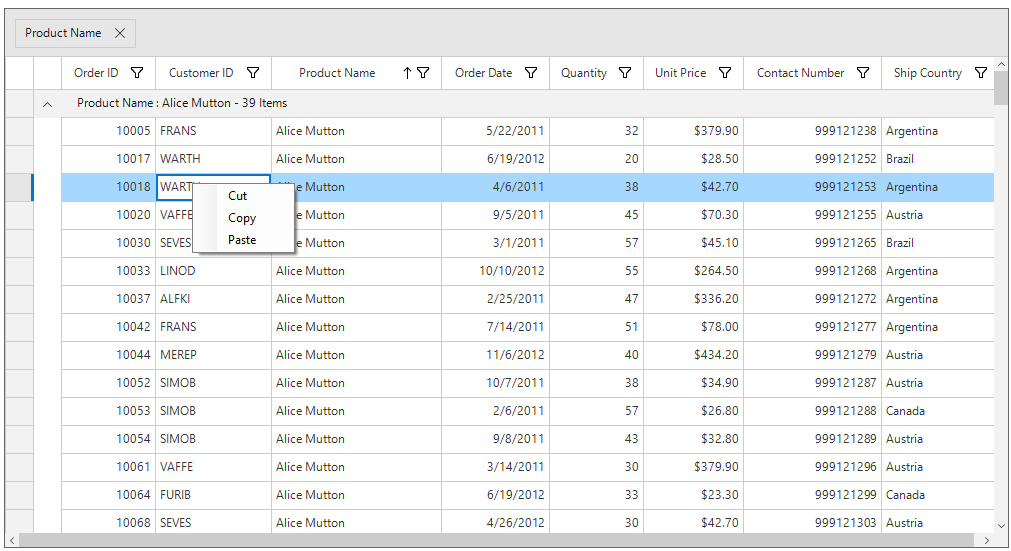
ContextMenu for Column Header
The context menu for the column header row can be set by using SfDataGrid.ColumnHeaderContextMenu property.
this.sfDataGrid1.ColumnHeaderContextMenu = new ContextMenuStrip();
this.sfDataGrid1.ColumnHeaderContextMenu.Items.Add("Sort Ascending", Image.FromFile("sortasc.png"), OnSortAscendingClicked);
this.sfDataGrid1.ColumnHeaderContextMenu.Items.Add("Sort Descending", Image.FromFile("sortdesc.png"), OnSortDescendingClicked);
this.sfDataGrid1.ColumnHeaderContextMenu.Items.Add("Clear Sorting", null, OnClearSortingClicked);
this.sfDataGrid1.ColumnHeaderContextMenu.Items.Add("Show GroupDropArea", null, OnShowGroupDropAreaClicked);Me.sfDataGrid1.ColumnHeaderContextMenu = New ContextMenuStrip()
Me.sfDataGrid1.ColumnHeaderContextMenu.Items.Add("Sort Ascending", Image.FromFile("sortasc.png"), OnSortAscendingClicked)
Me.sfDataGrid1.ColumnHeaderContextMenu.Items.Add("Sort Descending", Image.FromFile("sortdesc.png"), OnSortDescendingClicked)
Me.sfDataGrid1.ColumnHeaderContextMenu.Items.Add("Clear Sorting", Nothing, OnClearSortingClicked)
Me.sfDataGrid1.ColumnHeaderContextMenu.Items.Add("Show GroupDropArea", Nothing, OnShowGroupDropAreaClicked)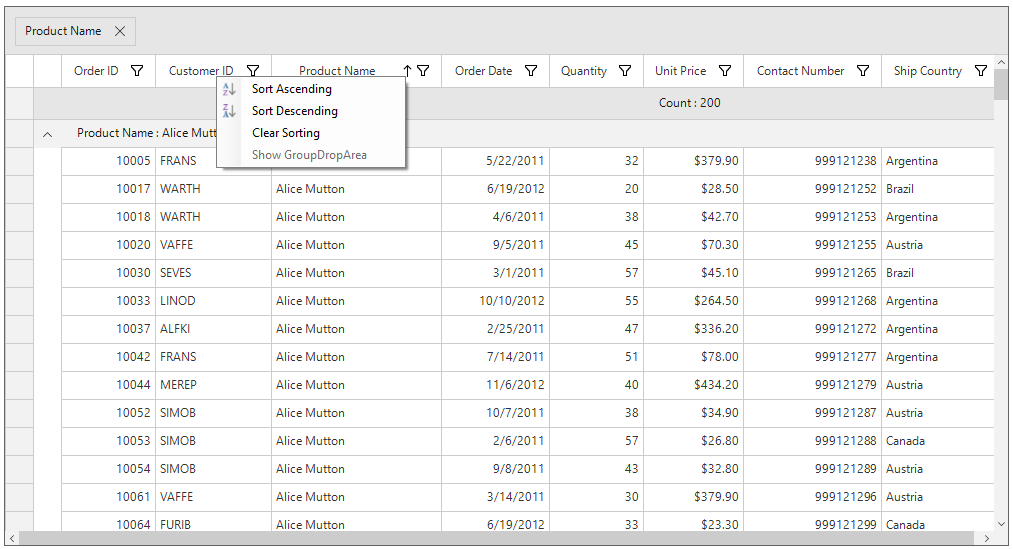
ContextMenu for RowHeader
The context menu for the row headers can be set by using SfDataGrid.RowHeaderContextMenu property.
this.sfDataGrid1.RowHeaderContextMenu = new ContextMenuStrip();
this.sfDataGrid1.RowHeaderContextMenu.Items.Add("Delete", null, OnDeleteClicked);Me.sfDataGrid1.RowHeaderContextMenu = New ContextMenuStrip()
Me.sfDataGrid1.RowHeaderContextMenu.Items.Add("Delete", Nothing, OnDeleteClicked)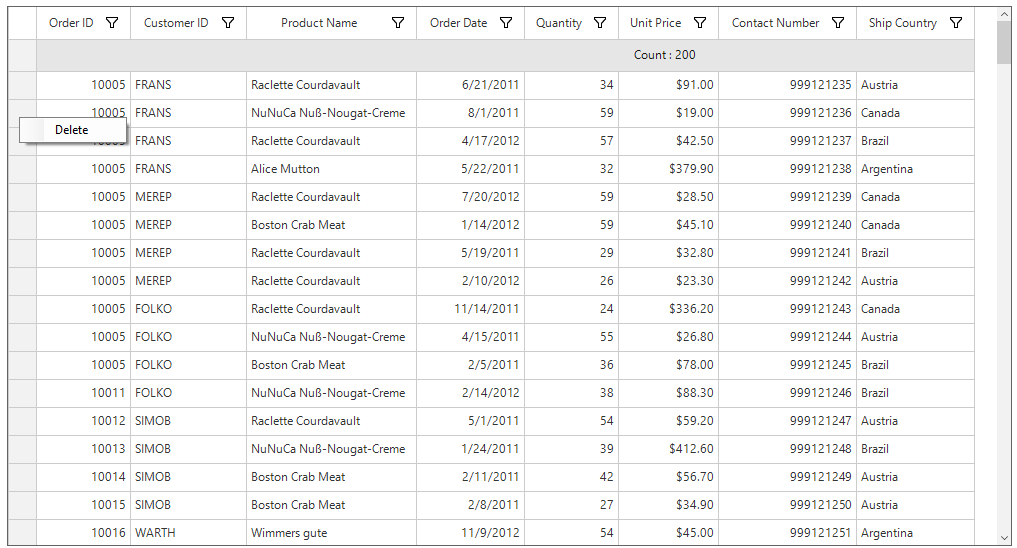
ContextMenu for GroupDropArea
The context menu for the group drop area can be set by using SfDataGrid.GroupDropAreaContextMenu property.
this.sfDataGrid1.GroupDropAreaContextMenu = new ContextMenuStrip();
this.sfDataGrid1.GroupDropAreaContextMenu.Items.Add("Hide GroupDropArea", null, OnHideGroupDropAreaClicked);
this.sfDataGrid1.GroupDropAreaContextMenu.Items.Add("Expand All", null, OnExpandAllClicked);
this.sfDataGrid1.GroupDropAreaContextMenu.Items.Add("Collapse All", null, OnCollapseAllClicked);
this.sfDataGrid1.GroupDropAreaContextMenu.Items.Add("Clear Groups", null, OnClearGroupsClicked);Me.sfDataGrid1.GroupDropAreaContextMenu = New ContextMenuStrip()
Me.sfDataGrid1.GroupDropAreaContextMenu.Items.Add("Hide GroupDropArea", Nothing, OnHideGroupDropAreaClicked)
Me.sfDataGrid1.GroupDropAreaContextMenu.Items.Add("Expand All", Nothing, OnExpandAllClicked)
Me.sfDataGrid1.GroupDropAreaContextMenu.Items.Add("Collapse All", Nothing, OnCollapseAllClicked)
Me.sfDataGrid1.GroupDropAreaContextMenu.Items.Add("Clear Groups", Nothing, OnClearGroupsClicked)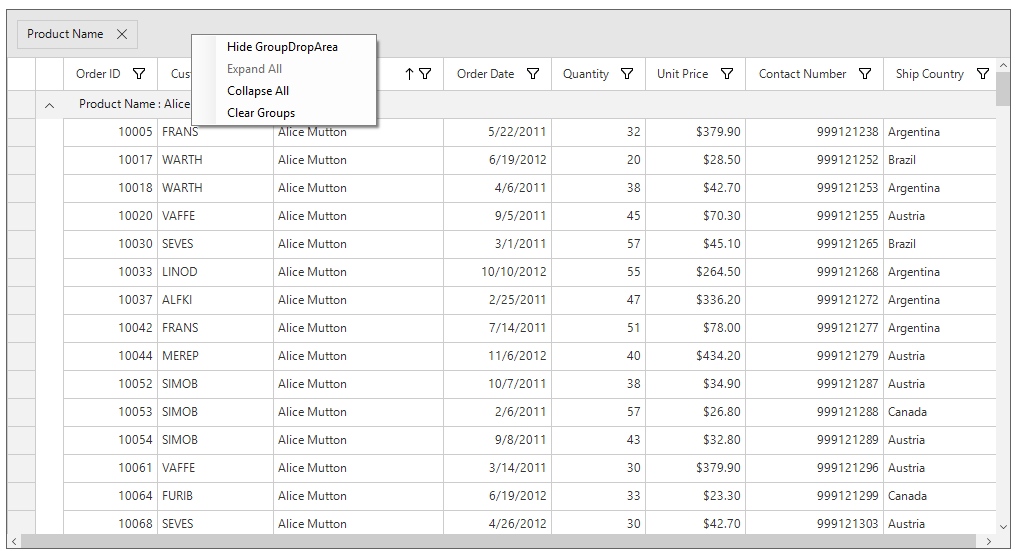
ContextMenu for GroupDropAreaItem
The context menu for the group drop area items can be set by using SfDataGrid.GroupDropAreaItemContextMenu property.
this.sfDataGrid1.GroupDropAreaItemContextMenu = new ContextMenuStrip();
this.sfDataGrid1.GroupDropAreaItemContextMenu.Items.Add("Expand All", null, OnItemExpandAllClicked);
this.sfDataGrid1.GroupDropAreaItemContextMenu.Items.Add("Collapse All", null, OnItemCollapseAllClicked);
this.sfDataGrid1.GroupDropAreaItemContextMenu.Items.Add("Clear Group", null, OnGroupClearClicked);Me.sfDataGrid1.GroupDropAreaItemContextMenu = New ContextMenuStrip()
Me.sfDataGrid1.GroupDropAreaItemContextMenu.Items.Add("Expand All", Nothing, OnItemExpandAllClicked)
Me.sfDataGrid1.GroupDropAreaItemContextMenu.Items.Add("Collapse All", Nothing, OnItemCollapseAllClicked)
Me.sfDataGrid1.GroupDropAreaItemContextMenu.Items.Add("Clear Group", Nothing, OnGroupClearClicked)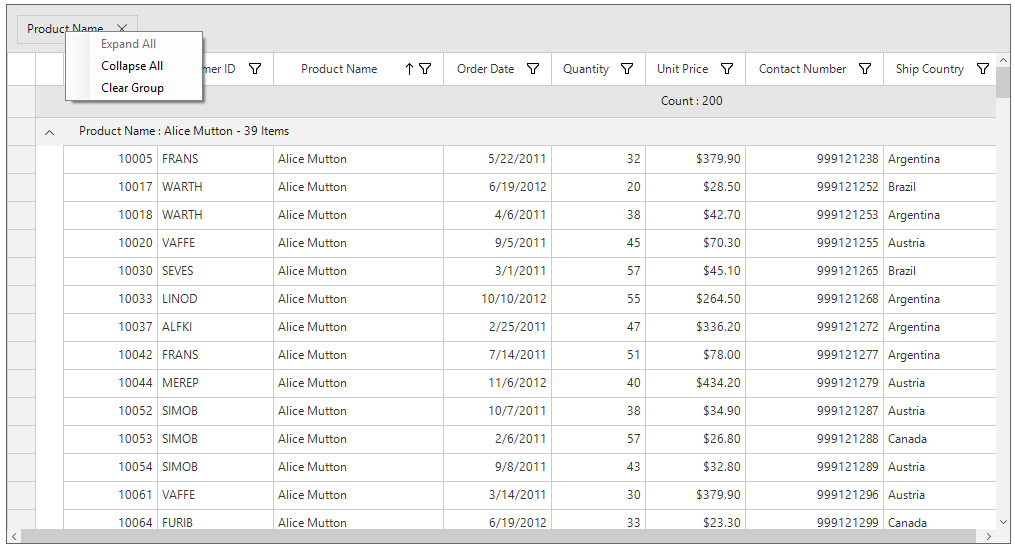
ContextMenu for GroupCaptionSummaryRow
The context menu for the group caption can be set by using SfDataGrid.GroupCaptionContextMenu property.
this.sfDataGrid1.GroupCaptionContextMenu = new ContextMenuStrip();
this.sfDataGrid1.GroupCaptionContextMenu.Items.Add("Expand", null, OnExpandClicked);
this.sfDataGrid1.GroupCaptionContextMenu.Items.Add("Collapse", null, OnCollapseClicked);Me.sfDataGrid1.GroupCaptionContextMenu = New ContextMenuStrip()
Me.sfDataGrid1.GroupCaptionContextMenu.Items.Add("Expand", Nothing, OnExpandClicked)
Me.sfDataGrid1.GroupCaptionContextMenu.Items.Add("Collapse", Nothing, OnCollapseClicked)
ContextMenu for GroupSummaryRow
The context menu for the group summary can be set by using SfDataGrid.GroupSummaryContextMenu property.
this.sfDataGrid1.GroupSummaryContextMenu = new ContextMenuStrip();
this.sfDataGrid1.GroupSummaryContextMenu.Items.Add("Sum", null, OnSumClicked);
this.sfDataGrid1.GroupSummaryContextMenu.Items.Add("Count", null, OnCountClicked);Me.sfDataGrid1.GroupSummaryContextMenu = New ContextMenuStrip()
Me.sfDataGrid1.GroupSummaryContextMenu.Items.Add("Sum", Nothing, OnSumClicked)
Me.sfDataGrid1.GroupSummaryContextMenu.Items.Add("Count", Nothing, OnCountClicked)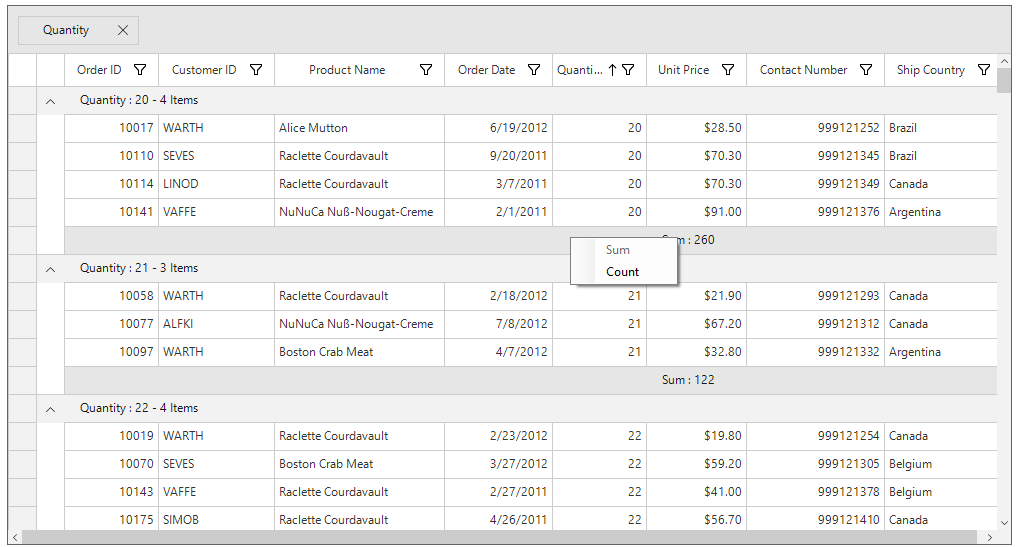
ContextMenu for TableSummaryRow
The context menu for the table summary can be set by using SfDataGrid.TableSummaryContextMenu property.
this.sfDataGrid1.TableSummaryContextMenu = new ContextMenuStrip();
this.sfDataGrid1.TableSummaryContextMenu.Items.Add("Sum", null, OnSumClicked);
this.sfDataGrid1.TableSummaryContextMenu.Items.Add("Count", null, OnCountClicked);Me.sfDataGrid1.TableSummaryContextMenu = New ContextMenuStrip()
Me.sfDataGrid1.TableSummaryContextMenu.Items.Add("Sum", Nothing, OnSumClicked)
Me.sfDataGrid1.TableSummaryContextMenu.Items.Add("Count", Nothing, OnCountClicked)
Appearance
The appearance of the context menus can be customized as given below.
this.sfDataGrid1.RecordContextMenu.BackColor = Color.AliceBlue;
this.sfDataGrid1.RecordContextMenu.ForeColor = Color.DarkBlue;Me.sfDataGrid1.RecordContextMenu.BackColor = Color.AliceBlue
Me.sfDataGrid1.RecordContextMenu.ForeColor = Color.DarkBlue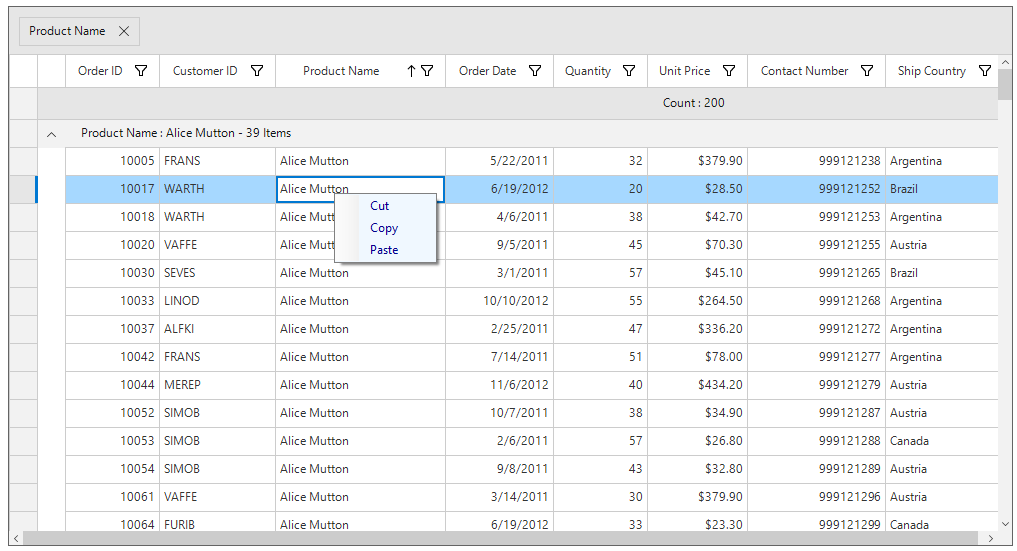
Cancel ContextMenu Opening
The context menu opening can be canceled for any particular cell/row or column through ContextMenuOpening event.
this.sfDataGrid1.ContextMenuOpening += SfDataGrid1_ContextMenuOpening;
private void SfDataGrid1_ContextMenuOpening(object obj, ContextMenuOpeningEventArgs e)
{
if (e.ColumnIndex == 1 && e.RowIndex == 1)
e.Cancel = true;
}AddHandler sfDataGrid1.ContextMenuOpening, AddressOf SfDataGrid1_ContextMenuOpening
Private Sub SfDataGrid1_ContextMenuOpening(ByVal obj As Object, ByVal e As ContextMenuOpeningEventArgs)
If e.ColumnIndex = 1 AndAlso e.RowIndex = 1 Then
e.Cancel = True
End If
End SubContextMenuOpened event occurs when any context menu is opened in SfDataGrid. This will not occur if ContextMenuOpening event is canceled.
Customization of Context Menu
Change the Menu Items when Opening the Context Menu.
The menu items for the context menu can be change when opening the context menu by handling the ContextMenuOpening event.
this.sfDataGrid1.ContextMenuOpening += SfDataGrid1_ContextMenuOpening;
private void SfDataGrid1_ContextMenuOpening(object obj, ContextMenuOpeningEventArgs e)
{
if (e.ContextMenutype == ContextMenuType.TableSummary)
{
e.ContextMenu.Items.Clear();
e.ContextMenu.Items.Add("Min", null, OnMinClicked);
e.ContextMenu.Items.Add("Max", null, OnMaxClicked);
}
}AddHandler sfDataGrid1.ContextMenuOpening, AddressOf SfDataGrid1_ContextMenuOpening
Private Sub SfDataGrid1_ContextMenuOpening(ByVal obj As Object, ByVal e As ContextMenuOpeningEventArgs)
If e.ContextMenutype = ContextMenuType.TableSummary Then
e.ContextMenu.Items.Clear()
e.ContextMenu.Items.Add("Min", Nothing, OnMinClicked)
e.ContextMenu.Items.Add("Max", Nothing, OnMaxClicked)
End If
End Sub
Create a New Column by using ColumnHeaderContextMenu
SfDataGrid allows to copy a column and paste it in a new column. ColumnHeaderContextMenu can be used to provide options for copy column and paste column. The below code example shows how to provide this support.
SfDataGrid grid = null;
GridColumn column = null;
GridColumn copiedColumn = null
public Form1()
{
InitializeComponent();
orderInfo = new OrderInfoCollection();
this.sfDataGrid1.DataSource = orderInfo.OrdersListDetails;
this.sfDataGrid1.ColumnHeaderContextMenu = new ContextMenuStrip();
this.sfDataGrid1.ColumnHeaderContextMenu.Items.Add("Copy Column", null, OnCopyColumnClicked);
this.sfDataGrid1.ColumnHeaderContextMenu.Items.Add("Paste Column", null, OnPasteColumnClicked);
this.sfDataGrid1.ContextMenuOpening += SfDataGrid1_ContextMenuOpening;
}
private void SfDataGrid1_ContextMenuOpening(object obj, ContextMenuOpeningEventArgs e)
{
if (e.ContextMenutype == ContextMenuType.ColumnHeader)
{
grid = (e.ContextMenuInfo as ColumnContextMenuInfo).DataGrid;
column = (e.ContextMenuInfo as ColumnContextMenuInfo).Column;
}
}
private void OnCopyColumnClicked(object sender, EventArgs e)
{
//The selected column stored in to CopiedColumn
copiedColumn = column;
}
private void OnPasteColumnClicked(object sender, EventArgs e)
{
if (copiedColumn != null)
{
var index = grid.Columns.IndexOf(column);
grid.Columns.Insert(index + 1, new GridTextColumn()
{
MappingName = copiedColumn.MappingName
});
}
}Dim grid As SfDataGrid = Nothing
Dim column As GridColumn = Nothing
Dim copiedColumn As GridColumn = Nothing
Public Sub New()
InitializeComponent()
orderInfo = New OrderInfoCollection()
Me.sfDataGrid1.DataSource = orderInfo.OrdersListDetails
Me.sfDataGrid1.ColumnHeaderContextMenu = New ContextMenuStrip()
Me.sfDataGrid1.ColumnHeaderContextMenu.Items.Add("Copy Column", Nothing, OnCopyColumnClicked)
Me.sfDataGrid1.ColumnHeaderContextMenu.Items.Add("Paste Column", Nothing, OnPasteColumnClicked)
AddHandler sfDataGrid1.ContextMenuOpening, AddressOf SfDataGrid1_ContextMenuOpening
End Sub
Private Sub SfDataGrid1_ContextMenuOpening(ByVal obj As Object, ByVal e As ContextMenuOpeningEventArgs)
If e.ContextMenutype = ContextMenuType.ColumnHeader Then
grid = (TryCast(e.ContextMenuInfo, ColumnContextMenuInfo)).DataGrid
column = (TryCast(e.ContextMenuInfo, ColumnContextMenuInfo)).Column
End If
End Sub
Private Sub OnCopyColumnClicked(ByVal sender As Object, ByVal e As EventArgs)
'The selected column stored in to CopiedColumn
copiedColumn = column
End Sub
Private Sub OnPasteColumnClicked(ByVal sender As Object, ByVal e As EventArgs)
If copiedColumn IsNot Nothing Then
Dim index = grid.Columns.IndexOf(column)
grid.Columns.Insert(index + 1, New GridTextColumn() With {.MappingName = copiedColumn.MappingName})
End If
End Sub
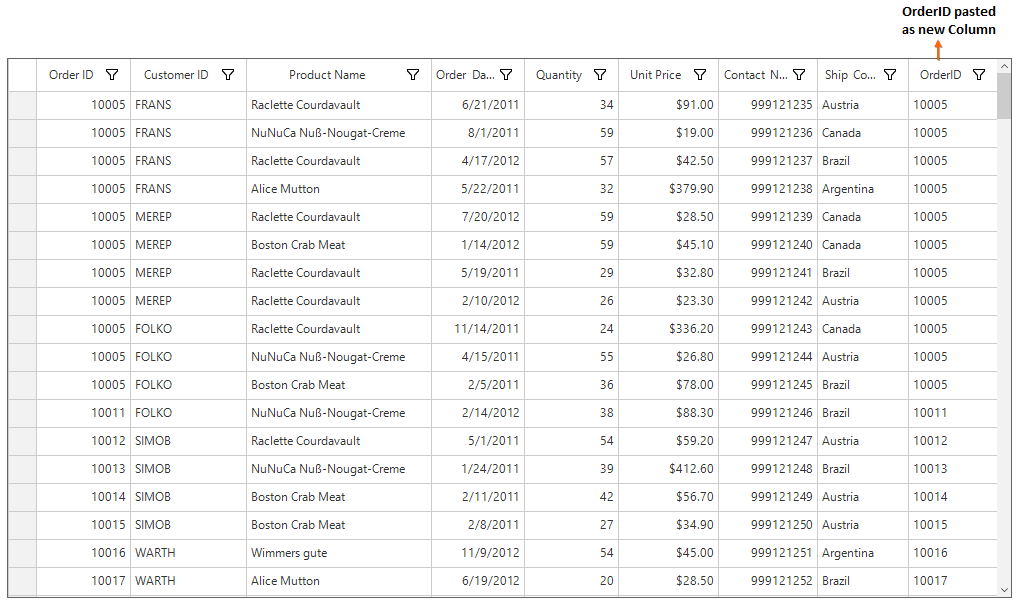
Clipboard Options by using RecordContextMenu
The below code example shows how to provide clipboard options for the SfDataGrid by using RecordContextMenu.
this.sfDataGrid1.RecordContextMenu = new ContextMenuStrip();
this.sfDataGrid1.RecordContextMenu.Items.Add("Cut", null, OnCutClicked);
this.sfDataGrid1.RecordContextMenu.Items.Add("Copy", null, OnCopyClicked);
this.sfDataGrid1.RecordContextMenu.Items.Add("Paste", null, OnPasteClicked);
private void OnCutClicked(Object sender, EventArgs e)
{
this.sfDataGrid1.ClipboardController.Cut();
}
private void OnCopyClicked(Object sender, EventArgs e)
{
this.sfDataGrid1.ClipboardController.Copy();
}
private void OnPasteClicked(Object sender, EventArgs e)
{
this.sfDataGrid1.ClipboardController.Paste();
}Me.sfDataGrid1.RecordContextMenu = New ContextMenuStrip()
Me.sfDataGrid1.RecordContextMenu.Items.Add("Cut", Nothing, AddressOf OnCutClicked)
Me.sfDataGrid1.RecordContextMenu.Items.Add("Copy", Nothing, AddressOf OnCopyClicked)
Me.sfDataGrid1.RecordContextMenu.Items.Add("Paste", Nothing, AddressOf OnPasteClicked)
private void OnCutClicked(Object sender, EventArgs e)
Me.sfDataGrid1.ClipboardController.Cut()
private void OnCopyClicked(Object sender, EventArgs e)
Me.sfDataGrid1.ClipboardController.Copy()
private void OnPasteClicked(Object sender, EventArgs e)
Me.sfDataGrid1.ClipboardController.Paste()Clear Filtering by using ColumnHeaderContextMenu
The below code example shows how to provide option to clear filters in all the columns by using ColumnHeaderContextMenu.
this.sfDataGrid1.ColumnHeaderContextMenu = new ContextMenuStrip();
this.sfDataGrid1.ColumnHeaderContextMenu.Items.Add("Clear Filtering", null, OnClearFilteringClicked);
void OnClearFilteringClicked(object sender, EventArgs e)
{
this.sfDataGrid1.ClearFilters();
}Me.sfDataGrid1.ColumnHeaderContextMenu = New ContextMenuStrip()
Me.sfDataGrid1.ColumnHeaderContextMenu.Items.Add("Clear Filtering", Nothing, AddressOf OnClearFilteringClicked)
void OnClearFilteringClicked(Object sender, EventArgs e)
Me.sfDataGrid1.ClearFilters()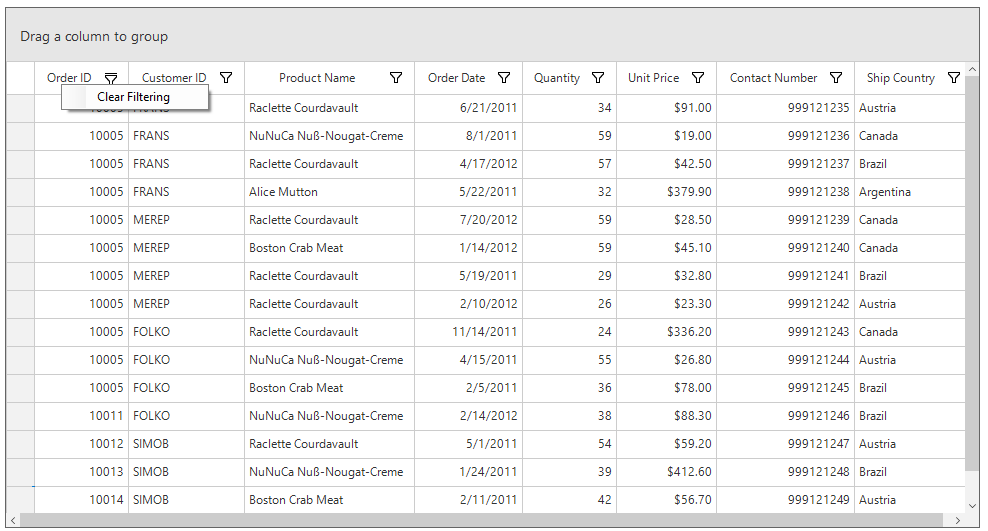
Column chooser
Columns visibility in the SfDataGrid can be changed at runtime by using the ColumnChooserPopup or ColumnChooser control.
Load column chooser pop-up
Column chooser pop-up can be enabled in the application by creating an instance of ColumnChooserPopup when passing SfDataGrid to the constructor. You can display the pop-up by using the Show method. Columns visibility will be changed when clicking OK based on the checked state of the checked list box of the column chooser pop-up.
//Attach the column chooser popup to the sfdatagrid.
ColumnChooserPopup columnChooser = new ColumnChooserPopup(this.sfDataGrid);
columnChooserPopup.Show();'Attach the column chooser popup to the sfdatagrid.
Dim columnChooser As New ColumnChooserPopup(Me.sfDataGrid)
columnChooserPopup.Show()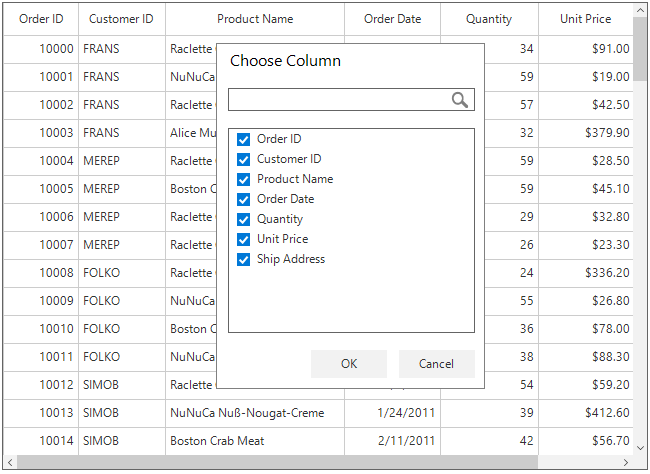
Load column chooser as control
Column chooser can also be loaded as a control by creating an instance of the ColumnChooser control and adding it to the container control of the application.
// Add column chooser as control
ColumnChooser columnChooser = new ColumnChooser(sfDataGrid);
columnChooser.Location = new Point(500, 10);
this.Controls.Add(columnChooser);' Add column chooser as control
Dim columnChooser As New ColumnChooser(sfDataGrid)
columnChooser.Location = New Point(500, 10)
Me.Controls.Add(columnChooser)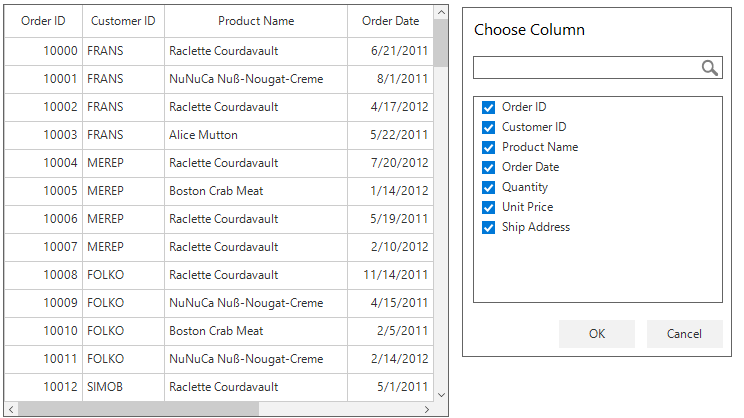
Appearance customization
Appearance of the column chooser can be customized by accessing the inner controls of the column chooser: CheckedListBox, OKButton, CancelButton, and SearchTextBox.
You can change the selection backcolor of the checked listbox by setting the style properties.
//Set the selection backcolor for the checked listbox.
ColumnChooserPopup columnChooser = new ColumnChooserPopup(this.sfDataGrid);
columnChooserPopup.ColumnChooser.CheckedListBox.Style.SelectionStyle.SelectionBackColor = Color.LightGreen;
columnChooserPopup.Show();'Set the selection backcolor for the checked listbox.
Dim columnChooser As New ColumnChooserPopup(Me.sfDataGrid)
columnChooserPopup.ColumnChooser.CheckedListBox.Style.SelectionStyle.SelectionBackColor = Color.LightGreen
columnChooserPopup.Show()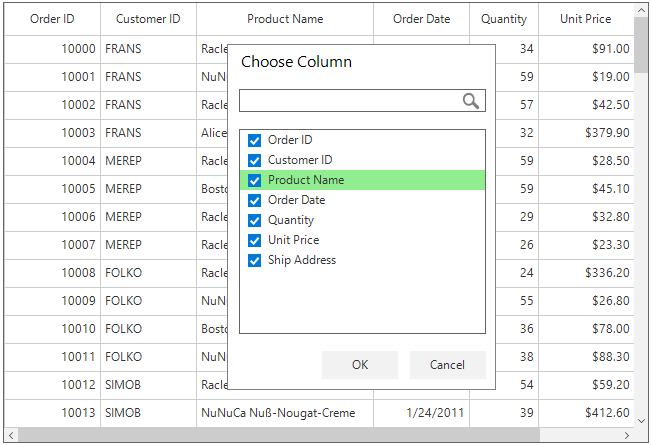
Loading custom column chooser
By default, the column chooser will be loaded with OK and Cancel buttons. Columns visibility will be applied only by clicking the OK button. You can also change the visibility by clicking the checked list box item.
Creating custom column chooser control
/// <summary>
/// Represents the class that provides the custom column chooser control.
/// </summary>
public class ColumnChooserExt : ColumnChooser
{
/// <summary>
/// The grid attached with the column chooser.
/// </summary>
private SfDataGrid dataGrid;
/// <summary>
/// Initializes a new instance of the sfDataGrid
/// </summary>
/// <param name="sfDataGrid">The data grid which needs to be attached to the control.</param>
public ColumnChooserExt(SfDataGrid sfDataGrid): base(sfDataGrid)
{
dataGrid = sfDataGrid;
}
/// <summary>
/// Overridden to updated the setting of the checked list box.
/// </summary>
protected override void AddCheckedListBox()
{
base.AddCheckedListBox();
this.CheckedListBox.CheckBoxSelectionMode = Syncfusion.WinForms.ListView.Enums.CheckBoxSelectionMode.CheckOnItemClick;
this.CheckedListBox.ItemChecked += CheckedListBox_ItemChecking;
}
/// <summary>
/// Change the visibility of the columns on checking the checked list box item.
/// </summary>
/// <param name="sender">The object of the sender.</param>
/// <param name="e">An <see cref=""/></param>
void CheckedListBox_ItemChecking(object sender, Syncfusion.WinForms.ListView.Events.ItemCheckedEventArgs e)
{
dataGrid.Columns[e.ItemData.ToString()].Visible = e.NewState == CheckState.Checked;
}
/// <summary>
/// Overridden to cancel the adding of OK button.
/// </summary>
protected override void AddOKButton()
{
// Do nothing to avod adding the OK button.
}
/// <summary>
/// Overridden to cancel the adding of Cancel button.
/// </summary>
protected override void AddCancelButton()
{
// Set the height for the checked listbox and column chooser.
this.CheckedListBox.Size = new Size(this.CheckedListBox.Size.Width, CheckedListBox.Size.Height + CancelButton.Height + 15);
this.MaximumSize = new Size(this.Size.Width, this.Size.Height - (CancelButton.Height + 15));
}
}''' <summary>
''' Represents the class that provides the custom column chooser control.
''' </summary>
Public Class ColumnChooserExt
Inherits ColumnChooser
''' <summary>
''' The grid attached with the column chooser.
''' </summary>
Private dataGrid As SfDataGrid
''' <summary>
''' Initializes a new instance of the sfDataGrid
''' </summary>
''' <param name="sfDataGrid">The data grid which needs to be attached to the control.</param>
Public Sub New(ByVal sfDataGrid As SfDataGrid)
MyBase.New(sfDataGrid)
dataGrid = sfDataGrid
End Sub
''' <summary>
''' Overridden to updated the setting of the checked listbox.
''' </summary>
Protected Overrides Sub AddCheckedListBox()
MyBase.AddCheckedListBox()
Me.CheckedListBox.CheckBoxSelectionMode = Syncfusion.WinForms.ListView.Enums.CheckBoxSelectionMode.CheckOnItemClick
AddHandler Me.CheckedListBox.ItemChecked, AddressOf CheckedListBox_ItemChecking
End Sub
''' <summary>
''' Change the visibility of the columns on checking the checked list box item.
''' </summary>
''' <param name="sender">The object of the sender.</param>
''' <param name="e">An <see cref=""/></param>
Private Sub CheckedListBox_ItemChecking(ByVal sender As Object, ByVal e As Syncfusion.WinForms.ListView.Events.ItemCheckedEventArgs)
dataGrid.Columns(e.ItemData.ToString()).Visible = e.NewState = CheckState.Checked
End Sub
''' <summary>
''' Overridden to cancel the adding of OK button.
''' </summary>
Protected Overrides Sub AddOKButton()
' Do nothing to avod adding the OK button.
End Sub
''' <summary>
''' Overridden to cancel the adding of Cancel button.
''' </summary>
Protected Overrides Sub AddCancelButton()
Me.CheckedListBox.Size = New Size(Me.CheckedListBox.Size.Width, CheckedListBox.Size.Height + CancelButton.Height + 15)
Me.MaximumSize = New Size(Me.Size.Width, Me.Size.Height - (CancelButton.Height + 15))
End Sub
End ClassAdding custom column chooser control
// Add column chooser as control
ColumnChooserExt columnChooser = new ColumnChooserExt(sfDataGrid);
columnChooser.Location = new Point(500, 10);
this.Controls.Add(columnChooser);' Add column chooser as control
Dim columnChooser As New ColumnChooserExt(sfDataGrid)
columnChooser.Location = New Point(500, 10)
Me.Controls.Add(columnChooser)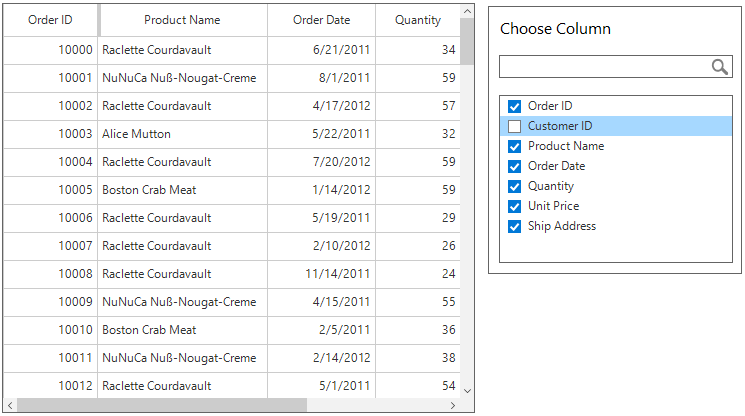
You can download the custom column chooser sample here.
ToolTip
SfDataGrid provides the support to show the pop-up window that displays the information when the mouse hover on the cells by using SfToolTip. The ToolTip for the SfDataGrid can be enabled by setting theSfDataGrid.ShowToolTip property to true.
this.sfDataGrid1.ShowToolTip = true;Me.sfDataGrid1.ShowToolTip = TrueThe ToolTip for any particular column can be enabled by setting GridColumnBase.ShowToolTip property to true.
this.sfDataGrid1.Columns["OrderID"].ShowToolTip = true;Me.sfDataGrid1.Columns("OrderID").ShowToolTip = TrueNOTE
GridColumnBase.ShowToolTip takes higher priority than SfDataGrid.ShowToolTip.
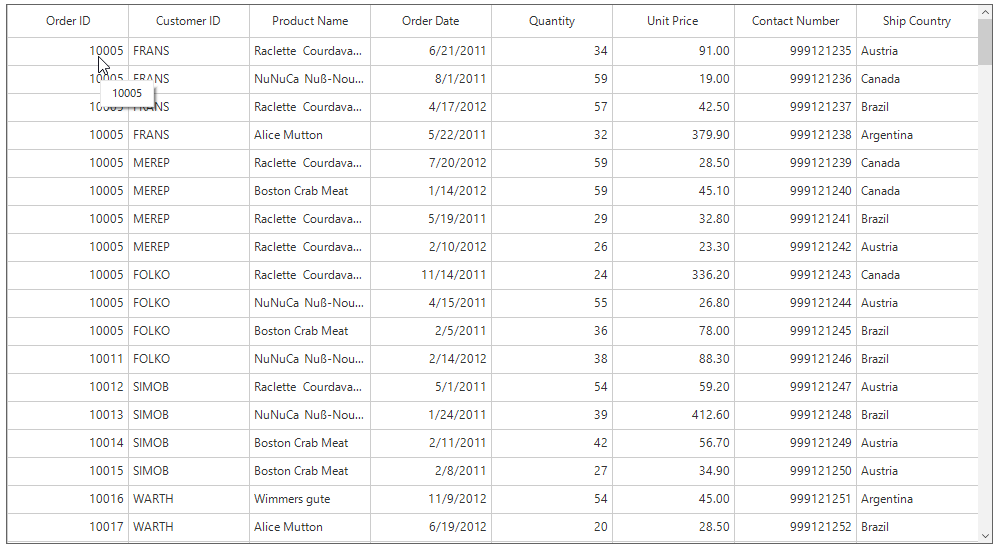
Displaying ToolTip on Header
The ToolTip can be displayed for the header cells by setting the SfDataGrid.ShowHeaderToolTip property to true.
this.sfDataGrid1.ShowHeaderToolTip = true;Me.sfDataGrid1.ShowHeaderToolTip = TrueThe header ToolTip for any particular column can be enabled by setting GridColumnBase.ShowHeaderToolTip property to true.
this.sfDataGrid1.Columns["OrderID"].ShowHeaderToolTip = true;Me.sfDataGrid1.Columns("OrderID").ShowHeaderToolTip = TrueNOTE
GridColumnBase.ShowHeaderToolTip takes higher priority than SfDataGrid.ShowHeaderToolTip.

Displaying ToolTip Only for the Trimmed Cells
By default, ToolTip will be displayed for all the cells. SfDataGrid provides support to display ToolTip only for the cells that contains trimmed text by setting value for SfDataGrid.ToolTipOption.ToolTipMode property as TrimmedCells.
this.sfDataGrid1.ToolTipOption.ToolTipMode = ToolTipMode.TrimmedCells;Me.sfDataGrid1.ToolTipOption.ToolTipMode = ToolTipMode.TrimmedCells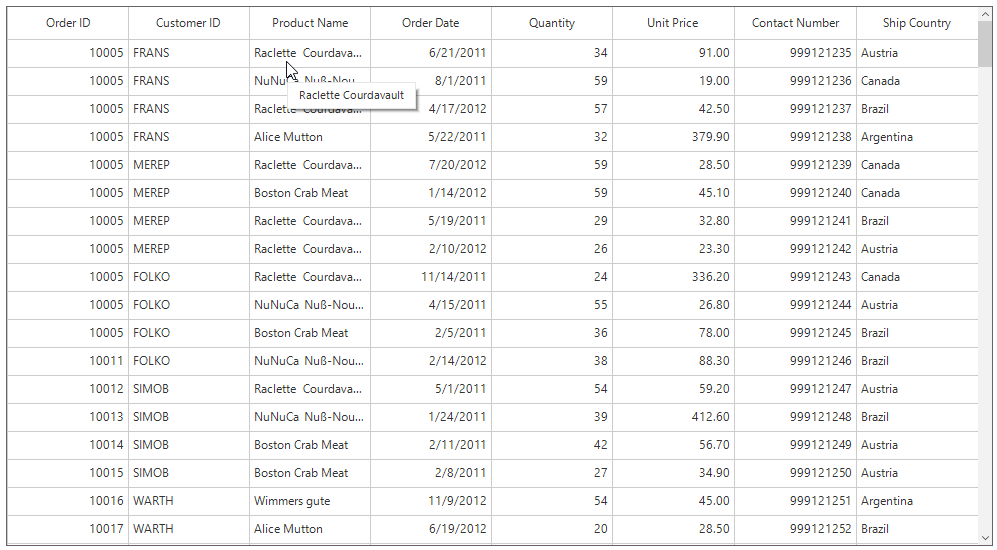
Setting ToolTip Delay
Initial Delay
The SfDataGrid.ToolTipOption.InitialDelay property provides supports to shorten or lengthen the time before displaying a ToolTip.
this.sfDataGrid1.ToolTipOption.InitialDelay = 1000;Me.sfDataGrid1.ToolTipOption.InitialDelay = 1000Auto Pop Delay
The SfDataGrid.ToolTipOption.AutoPopDelay property provides support to shorten or lengthen the time duration that the tooltip is displayed when the mouse pointer is on a cell.
this.sfDataGrid1.ToolTipOption.AutoPopDelay = 3000;Me.sfDataGrid1.ToolTipOption.AutoPopDelay = 3000Appearance
Styling
SfDataGrid allows to customize the appearance of the ToolTip through SfDataGrid.Style.ToolTipStyle property.
this.sfDataGrid1.Style.ToolTipStyle.BackColor = Color.AliceBlue;
this.sfDataGrid1.Style.ToolTipStyle.ForeColor = Color.Red;
this.sfDataGrid1.Style.ToolTipStyle.BorderThickness = 2;
this.sfDataGrid1.Style.ToolTipStyle.BorderColor = Color.DarkBlue;Me.sfDataGrid1.Style.ToolTipStyle.BackColor = Color.AliceBlue
Me.sfDataGrid1.Style.ToolTipStyle.ForeColor = Color.Red
Me.sfDataGrid1.Style.ToolTipStyle.BorderThickness = 2
Me.sfDataGrid1.Style.ToolTipStyle.BorderColor = Color.DarkBlue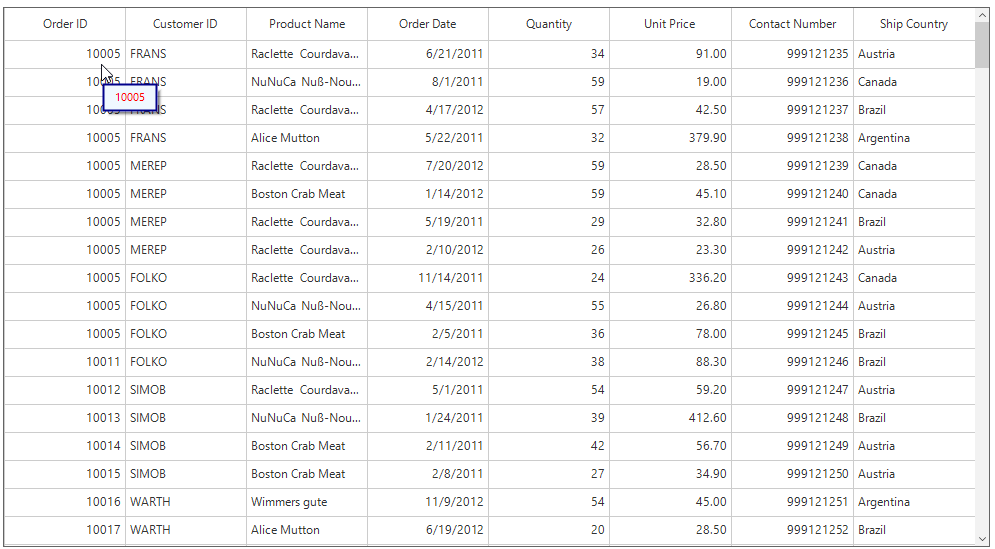
Conditional Styling
SfDataGrid allows to customize the appearance of the ToolTip based on conditions through ToolTipOpening event.
this.sfDataGrid1.ToolTipOpening += SfDataGrid1_ToolTipOpening1;
private void SfDataGrid1_ToolTipOpening1(object sender, ToolTipOpeningEventArgs e)
{
if(e.RowIndex%2 == 0)
{
e.ToolTipInfo.Items[0].Style.BackColor = Color.PaleTurquoise;
e.ToolTipInfo.Items[0].Style.ForeColor = Color.Red;
}
}AddHandler sfDataGrid1.ToolTipOpening, AddressOf SfDataGrid1_ToolTipOpening1
Private Sub SfDataGrid1_ToolTipOpening1(ByVal sender As Object, ByVal e As ToolTipOpeningEventArgs)
If e.RowIndex Mod 2 = 0 Then
e.ToolTipInfo.Items(0).Style.BackColor = Color.PaleTurquoise
e.ToolTipInfo.Items(0).Style.ForeColor = Color.Red
End If
End Sub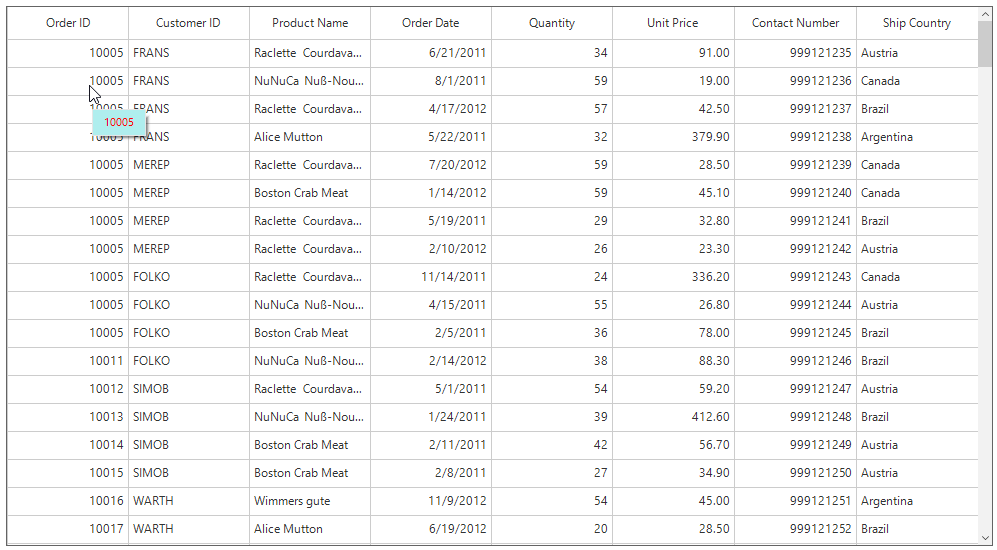
Cancel ToolTip Opening
SfDataGrid allows to cancel displaying the ToolTip for any particular cell/row or column by handling the ToolTipOpening event.
this.sfDataGrid1.ToolTipOpening += SfDataGrid1_ToolTipOpening1;
private void SfDataGrid1_ToolTipOpening1(object sender, ToolTipOpeningEventArgs e)
{
if (e.RowIndex == 1 && e.ColumnIndex == 3)
e.Cancel = true;
}AddHandler sfDataGrid1.ToolTipOpening, AddressOf SfDataGrid1_ToolTipOpening1
Private Sub SfDataGrid1_ToolTipOpening1(ByVal sender As Object, ByVal e As ToolTipOpeningEventArgs)
If e.RowIndex = 1 AndAlso e.ColumnIndex = 3 Then
e.Cancel = True
End If
End SubToolTipOpened event occurs when ToolTip for any cell is displayed. This will not occur if the ToolTipOpening event is canceled.
Customization of ToolTip
Change the Display Text for a Cell
By default, SfDataGrid displays the ToolTip with the cell content as the ToolTip text. The ToolTip text for any particular cell can be changed by handling the ToolTipOpening event.
this.sfDataGrid1.ToolTipOpening += SfDataGrid1_ToolTipOpening1;
private void SfDataGrid1_ToolTipOpening1(object sender, ToolTipOpeningEventArgs e)
{
if (e.DisplayText == "6/21/2011")
{
e.ToolTipInfo.Items[0].Text = "June 21, 2011";
}
}AddHandler sfDataGrid1.ToolTipOpening, AddressOf SfDataGrid1_ToolTipOpening1
Private Sub SfDataGrid1_ToolTipOpening1(ByVal sender As Object, ByVal e As ToolTipOpeningEventArgs)
If e.DisplayText = "6/21/2011" Then
e.ToolTipInfo.Items(0).Text = "June 21, 2011"
End If
End Sub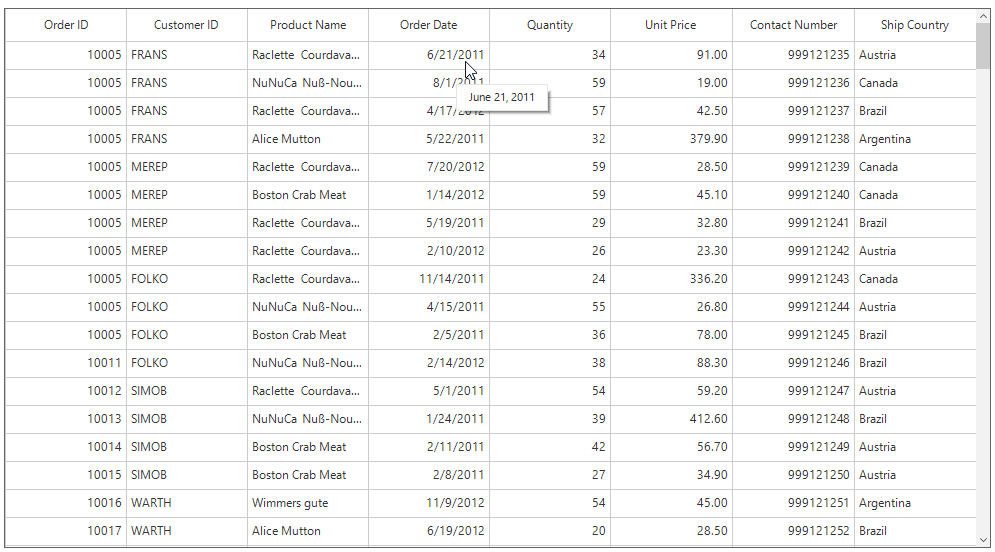
this.sfDataGrid1.ToolTipOpening += SfDataGrid1_ToolTipOpening1;
private void SfDataGrid1_ToolTipOpening1(object sender, ToolTipOpeningEventArgs e)
{
if (e.DisplayText == "Frans")
{
e.ToolTipInfo.Items[0].Text = String.Empty;
e.ToolTipInfo.Items[0].Image = Image.FromFile(@"Images/FRANS.png");
}
}AddHandler sfDataGrid1.ToolTipOpening, AddressOf SfDataGrid1_ToolTipOpening1
Private Sub SfDataGrid1_ToolTipOpening1(ByVal sender As Object, ByVal e As ToolTipOpeningEventArgs)
If e.DisplayText = "Frans" Then
e.ToolTipInfo.Items(0).Text = String.Empty
e.ToolTipInfo.Items(0).Image = Image.FromFile("Images/FRANS.png")
End If
End Sub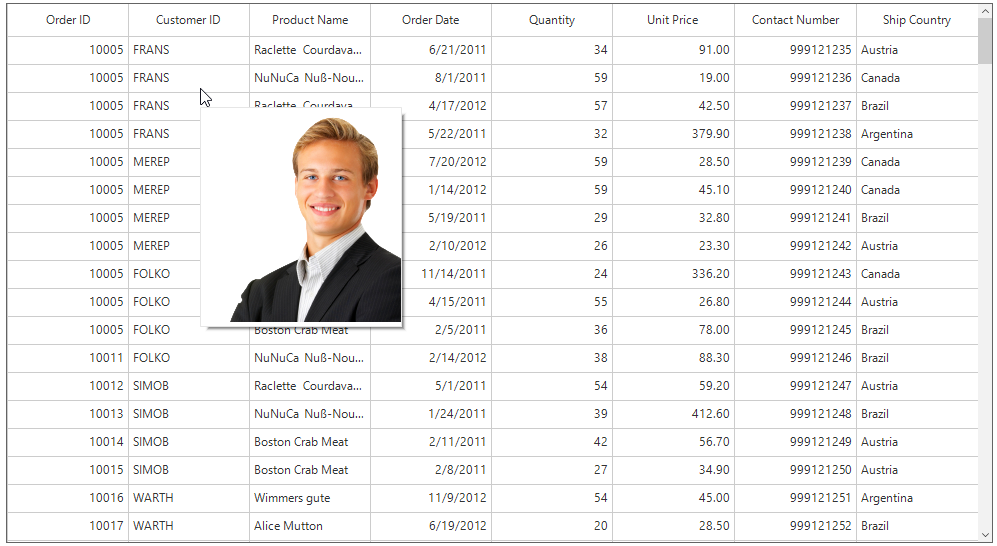
Display ToolTip with Beak
ToolTip can be displayed with beak by handling the ToolTipOpening event.
this.sfDataGrid1.ToolTipOpening += SfDataGrid1_ToolTipOpening1;
private void SfDataGrid1_ToolTipOpening1(object sender, ToolTipOpeningEventArgs e)
{
e.ToolTipInfo.ToolTipStyle = Syncfusion.WinForms.Controls.Enums.ToolTipStyle.Balloon;
e.ToolTipInfo.ToolTipLocation = Syncfusion.WinForms.Controls.Enums.ToolTipLocation.BottomRight;
}AddHandler sfDataGrid1.ToolTipOpening, AddressOf SfDataGrid1_ToolTipOpening1
Private Sub SfDataGrid1_ToolTipOpening1(ByVal sender As Object, ByVal e As ToolTipOpeningEventArgs)
e.ToolTipInfo.ToolTipStyle = Syncfusion.WinForms.Controls.Enums.ToolTipStyle.Balloon
e.ToolTipInfo.ToolTipLocation = Syncfusion.WinForms.Controls.Enums.ToolTipLocation.BottomRight
End Sub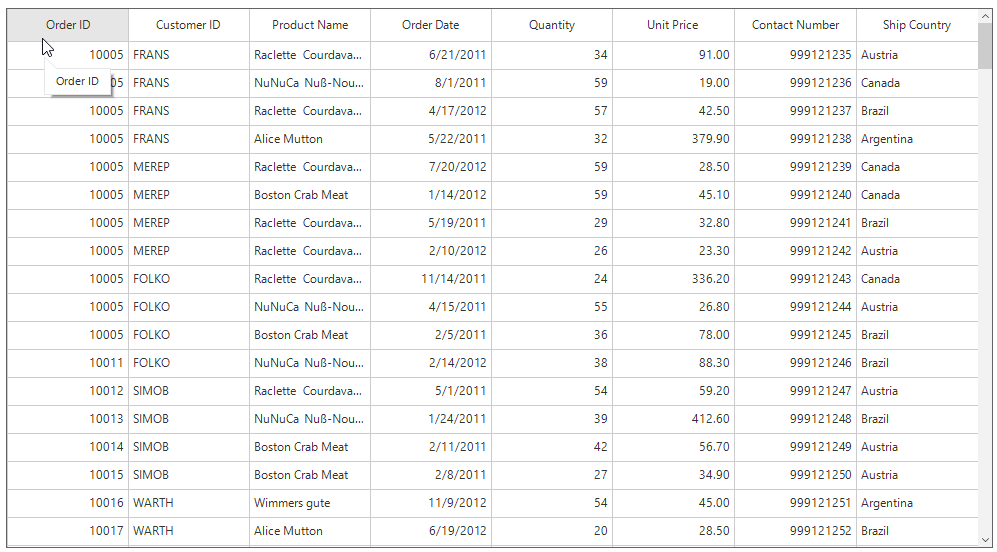
Showing ToolTip for empty cells
By default, DataGrid do not show tooltip for empty cells. You can show tooltip for empty cells by handling the ToolTipOpening event.
this.sfDataGrid1.ToolTipOpening += SfDataGrid1_ToolTipOpening;
private void SfDataGrid1_ToolTipOpening(object sender, ToolTipOpeningEventArgs e)
{
if (string.IsNullOrEmpty(e.DisplayText))
{
e.ToolTipInfo.Items[0].Text = "CurrentCell value is Empty";
}
}AddHandler sfDataGrid1.ToolTipOpening, AddressOf SfDataGrid1_ToolTipOpening
Private Sub SfDataGrid1_ToolTipOpening(ByVal sender As Object, ByVal e As ToolTipOpeningEventArgs)
If String.IsNullOrEmpty(e.DisplayText) Then
e.ToolTipInfo.Items(0).Text = "CurrentCell value is Empty"
End If
End Sub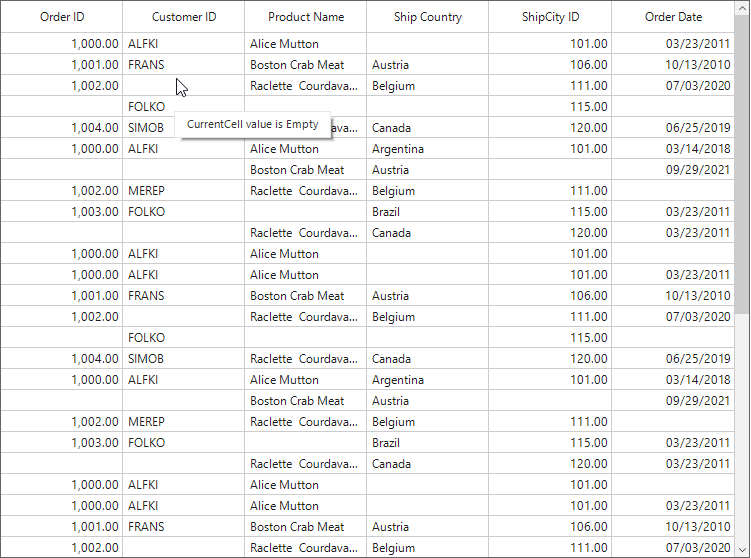
NOTE
SfToolTip has used for the ToolTip support in the SfDataGrid. Refer user guide of SfToolTip for more customizations options.